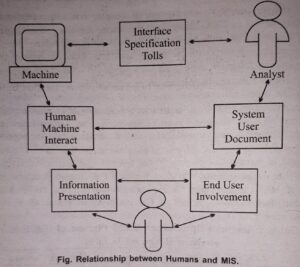
In what way information system depends on People? Discuss.
In what way information system depends on People? Discuss.
Ans.
Information systems are the glue between people and computers. Both the social and business environments are in a continual, some might say chaotic, state of change while computer hardware continues to double its performance about every 18 months. This presents a major challenge for information system The term developers, user-friendly is an old one, but one which has come to take on a multitude of meanings. However, in today’s context we might well take a user-friendly system to be one where the technology fits the user’s cognitive models of the activity in hand. This article looks at the relationship between information systems and the changing demands of their users as the underlying theme for the current issue of Cognition, Technology and Work. People, both as individuals and organisations, change. The functionalist viewpoint, which attempts to freeze and inhibit such change, has failed systems developers on numerous occasions. Responding to, and building on, change in the social environment is still a significant research issue for information systems specialists who need to be able to create living information systems.
At the level of an officer and an executive, the MIS does the job of data manipulation and integration. It analyses the data in a predetermined manner. This means that the knowledge of business is transferred from an individual to the MIS and is made available to all in the organisation. This change arising out of the MIS creates a sense of being neglected for knowledge, information and advice. The psychological impact is larger if the person is not able to cope up with this change by expanding or enriching the job and the position held by him.
The manager, holding a position in the top or middle management, suffers from fear of challenge and exposure. The MIS makes his competitors more effective as they have access to the information and have an ability to interpret. This leads to a situation where he is afraid that his position, decision and defence will be challenged and may be proved wrong sometimes. The risk of adverse exposure to the higher management also increases. The effects so far pointed out are all negative and they are seen only in a few cases.
The positive effects on the individuals at all levels are that they have become more effective operators. The time and energy which was spent earlier in unproductive work is now applied for a productive work. Some are able to use their analytical skills and knowledge with the information support for improving their position in the organisation. Managers, having improved their decision-making ability, are able to handle the complex situations with relative ease. Some are benefited by improving their performance and being held in high esteem by the higher management.
The enterprising managers are able to use the systems and the models for trying out a number of alternatives in a given problem situation. The impact of the MIS on people of the organisation is phenomenal as it has made the same body of people collectively more effective and productive.
Information systems depend on people that are actually the human factors in MIS. These human factors are the “physiological, psychological and training factors that are to be considered in use, development of hardware, software and procedure to ensure that humans can interface with machines efficiently and effectively.
Human factors in MIS mean practice of designing products so that the user can perform required use, operation, service and supportive tasks with a minimum of stress and efficiency. To accomplish this designer must understand and acknowledge the needs, characteristic, capabilities and limitations of the intended user and design from the human out, making the design fit the user instead of forcing the user to fit the design.
From the conceptualization through the implementation and use of MIS the user plays a key role. Following table relates the human factors focus areas to the appropriate stage of system development.
Table: Relationship between SDLC Phases of MIS and Humans (Liveware in MIS)
| SDLC Stages | Human Factors |
| Feasibility Study | (1) User/analyst Interface |
| (2) Composition of Development | |
| (3) DFD | |
| Requirement Analysis | (4) Communication |
| (5) Graphics techniques | |
| System Specification | (6) Prototyping |
| (7) 4 GL | |
| Program Design and Development | (8) Guidelines for designing the user interface |
| (9) Application generators | |
| (10) User acceptance test | |
| System Test, Implementation and Production | (11) Using the man/machine interface |
| (12) Combat of user resistance to change | |
| (13) System documentation | |
| (14) User training and learning |
The following figure illustrates the relationship between humans and user.







